Travelling the Pencil Way: Learning of the Ancients: Rock Art
May 13, 2009
I find the confluence of human and geographical history to be fascinating, and one of the best examples of that is pre-Columbian American cultures, and the hints the different societies left us. The Northern Paiutes of Central/Southeastern Oregon did not use stone-based architecture, and their nomadic lifestyle meant fewer long-established civic centers to leave obvious traces. That is not to say that echoes are not still heard, that physical evidence is lacking. David and I found these petroglyphs last year in the Malheur area:

Petroglyphs--possibly Northern Paiute?--in the Malheur area, southeastern Oregon.
All of my life I have scoured the dirt and dust and rocks of campsites and trails hoping to find what I am not trained to do so: romantically I have always wanted to find arrowheads. This came to such an intensity, with so many false starts, on our recent trip that I resolved to start a “not-an-arrowhead” collection for my piles of extremely pointy-shaped–but totally natural–rocks. From my reference, happening upon any Indian artifact is tantamount to unearthing gold or some sort of grail. Rare and awesome.
The American Southwest is a different world for me in this respect. Ancestral Puebloans built complex urban apartments in stone and lived in them for centuries. Denser, longer-lived cultures expressed occurrences and spiritualities on rocks. These things are still there, quiet and yet still powerfully evocative. And as we started to find rock art on our trip, I realized how profound it feels when I see it.
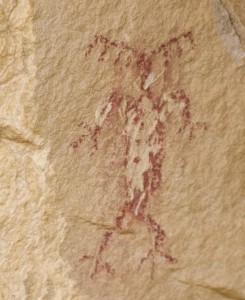
Detail of Human-figure pictograph in western Colorado.
Something about this particular trip made me more averse to crowds than usual, and it seemed like things had immensely more meaning when reflected upon in solitude. Thus we didn’t head for the well-known sites, but instead made it a point of seeking out the quieter spaces. That, you could say, was a running theme in general.
Our most wonderful find was based on a vague tip from a local. Very vague. We knew that there were, in his words, “Indian ruins” “at the base of each Cock’s Comb, if you are lucky enough to spot them”. This described a large area of wilderness. We decided to hike and see what we could find. We stomped out an hour or so in handsome, just-north-of-the-Grand-Canyon territory, but at the turnaround point I was sad that we had found nothing of indigenous note.
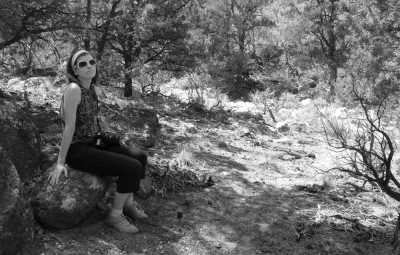
I am sad because we have found no rock art.
On our way back, I was stubborn about peering under and over things. At one point I became obsessed with an overhang hidden behind a healthy stand of sagebrush. It just seemed right. Nothing was obviously there, and I had walked up near to it inquisitively on our way out, unsuccessfully. This time I was more tenacious. Good thing. It was a fascinating discovery.
Disclaimer: Any interpretations I posit here are extremely non-scientific. I have a lot to learn on this subject.
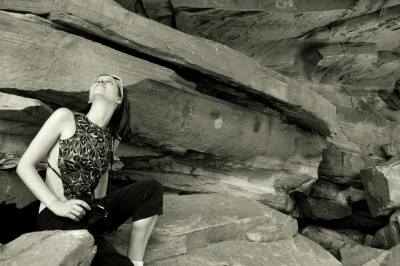
I am looking around at the varied, layered, evocative rock art in the cave-overhang. You can see some on the rock in the middle of the photo.

Most of the images at the site were pictographs (i.e. painted), but this elaborate spiral design was pecked into the rock. Spirals are used widely in Southwestern rock art and have a number of meanings, many of them spiritual, related to emergence, migration and self-discovery.

Detail of pictographs. Spotting the red figure is what led me to the cave. The images on the upper right seem to correspond to a key in the book "Rock Art Symbols of the Greater Southwest" (by Alex Patterson). They closely match symbols for a warrior or victorious hunter (left figure in red) and a dead/vanquished "headless" figure (white, upside down). But this is just a guess by a complete neophyte. Note an additional figure in white at left.
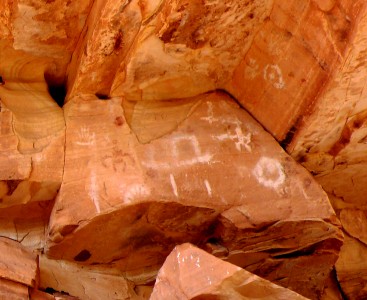
More detail. Some of these are clearly handprints. The hat-shaped symbol might be a cloud. Another warrior figure in white. The circle-with-a-dot motifs could indicate several things, including an enclosure or (euphemistically) a female symbol.
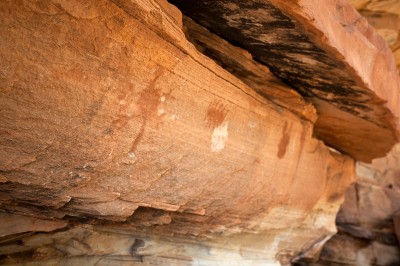
These elements were some of the best preserved. There were so many pictographs in this shelter that I wonder how long it was used and whether subsequent generations continued the decorative work. The middle symbol here appears to be a centipede or a bug, an image sometimes associated with death.
Scattered near the mouth of the cave-overhang were numerous flakes and pieces of stone that had been worked. I did not spot any intact arrow- or spear-heads but noted several broken or cast-off points. I did my best not to disturb any artifacts–I have a strong moral imperative to leave these ancient sites as they were found and as they have been for centuries.
This experience, as well as subsequent ones on the trip, leave me wanting to learn more, much more. I purchased the book Rock Art Symbols of the Greater Southwest by Alex Patterson while we were traveling, and will likely acquire a few more titles in this subject.
Recently Reviewed
Get the Books
Read my Reviews
Related Posts
- Artifacts
June 17, 2008 - Travelling the Pencil Way: An Overview
May 10, 2009 - Playing with Rocks
April 22, 2008 - Indian Creek
June 17, 2008 - Along the Deschutes: Three eras, one place
February 14, 2010



